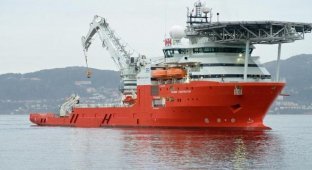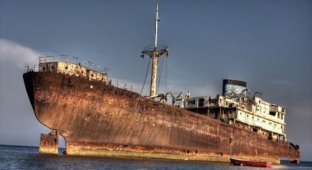The history of the rebellious “Bounty”: how it happened (20 photos)
Everyone has seen an advertisement for chocolate with a name that sounds like a mutinous ship. The advertisement clearly hints at freedom, peace and earthly paradise to those who consume this product. The commercial is clearly aimed at people who do not know the real story about the Bounty ship.
The story of the voyage of the English warship "Bounty" for breadfruit seedlings, the vicissitudes of this dramatic voyage were not lost even among the turbulent events of the 18th century, rich in mutinies, geographical discoveries and other exciting adventures.

The British warship "Bounty" on April 3, 1789 (according to some sources, April 4), under the leadership of Captain Bligh, sailed from the shores of Tahiti towards the Caribbean archipelago with valuable cargo on board. Breadfruit seedlings, the fruits of which were supposed to feed slaves on the sugar cane plantations of English colonists on the islands of the West Indies, however, did not achieve their goal: a mutiny broke out on the ship, as a result of which not only the plants suffered.
As a result of this mutiny and subsequent events, a hitherto unknown island was discovered, novels were written, films were made, and thanks to the efforts of copywriters, the dramatic voyage of the Bounty to the southern seas is now tightly linked in the public consciousness with heavenly pleasure.

On Christmas Eve 1787, the three-masted schooner Bounty set sail from the English harbor of Portsmund. There have been rumors for a long time about where and why this ship is heading, but the course and official goal of the expedition were announced to the sailors already on the open sea. The ship had an exotic destination: not to the New World, not to wild Africa, not to the fabulous, but already familiar India, not to the shores of New Holland (Australia) and New Zealand - the path lay to a paradise island in the South Seas, as then called the tropical region of the Pacific Ocean.

The mission, indeed, was unique: the schooner of the British Royal Navy did not set off in search of new lands or to fight the natives, and not even for black slaves or untold treasures. The Bounty team had to reach the paradise island of Tahiti, find and deliver to England a miracle plant, with the help of which it was planned to carry out an economic revolution. The goal of the long journey was breadfruit seedlings.

At the end of the 18th century, as a result of the American War of Independence, the British Empire lost its richest North American colonies. The infringement of political ambitions is nothing compared to the economic defeat that English businessmen suffered. Of course, in Jamaica and St. Vincent there was still a good harvest of sugar cane, the sale of which brought decent income to businessmen and the state treasury, but... The fact is that this very cane was grown by black slaves from Africa, who were fed yams and bananas, and grain and bread flour for them were brought from the American continent.
The independence of the United States of America hit the British slave owners hard. Now Americans had to pay completely different money for grain or import it from Europe. Both were expensive and significantly reduced the income from the sale of everything that slaves grew on the plantations. The increased costs of maintaining slaves, to put it mildly, upset English businessmen. It was necessary to somehow save the situation - to look for cheap bread. It was then that they remembered that travelers who had visited Tahiti often described a certain “bread fruit”. These fruits grow on tree branches, have a pleasant sweet taste and are the main food of local residents for eight months of the year. The schooner "Bounty" set off for this manna from heaven.

The famous English traveler Captain Cook wrote that in Polynesia, in Tahiti, bread grows on trees. This was not a metaphor - it was about a plant from the mulberry family that produces nutritious and tasty fruits the size of a coconut. When the most advanced English planters from the West Indian Islands read Cook's travel notes, which included information about breadfruit, they realized that the philosopher's stone, at least on the scale of one plantation, had been found. A brilliant business idea dawned on their bright heads: to transport breadfruit seedlings from Tahiti and feed the slaves with its fruits, thus saving a lot of money on the purchase of real bread. According to estimates, the profit from each plantation should have doubled from this innovation.
The people who mastered the overseas colonies in those days were decisive and fearless, therefore, without fear of the wrath of their superiors, they sent a request to King George III of England to help spread breadfruit in the places of their settlements. The king was inspired by the needs of the colonists and issued an order to the Admiralty: to equip a ship to Tahiti to collect and deliver shoots of the amazing plant to the planters of the West Indies.
The British navy did not have a suitable ship capable of accommodating, in addition to crew and provisions, hundreds of seedlings that required special care along the way. It took too long to build a new ship. The Admiralty bought the three-masted sailing ship Betia from a private shipowner for £1,950, which was rebuilt, equipped with cannons and entered into the Royal Navy under the name Bounty. The relatively small dimensions of the ship (displacement 215 tons, length on the upper deck 27.7 meters and width 7.4 meters), characteristic of other sailing ships of that time, were compensated by its large carrying capacity and excellent seaworthiness, and its flat bottom was supposed to protect against catastrophic collisions with reefs.

If you imagine for just a moment life on military sailing ships of the 18th century, you won’t be surprised at the frequent riots on them. The captains had unlimited power over the crew, even over the officers - what to say about the lower ranks, who could simply be strung up on the yardarm without unnecessary delay for disobedience and intimidation of others. Punishment in the form of flogging was also common. On small ships, as a rule, there was incredible crowding, there was often not enough water, the crew suffered from scurvy, which claimed many lives. Strict discipline, arbitrariness on the part of captains and officers, and inhuman living conditions more than once provoked bloody clashes on ships. In England, there were few people willing to voluntarily serve in the Royal Navy; forced recruitment flourished: special detachments caught merchant marine sailors and delivered them in chains to the Royal ships.

A young but experienced navigator, Lieutenant William Bligh, was appointed commander of the Bounty. By the age of 33, he had already sailed in the South Seas on the ships of the famous Cook, visited Polynesia, and knew the West Indies well, where he was supposed to deliver breadfruit seedlings. Unfortunately, in addition to good experience in navigation, Bligh had a bad character and instability, and considered brute force to be the best way to communicate with the crew.

On November 29, 1787, the Bounty with a crew of 48 people left England to cross the Atlantic Ocean, round Cape Horn and, entering the Pacific Ocean, go to the island of Tahiti. The destination of the return trip was the island of Jamaica - across the Indian Ocean, past the Cape of Good Hope. The voyage was planned for two years.
Due to delays caused by the Admiralty, the ship set off late when severe storms raged off Cape Horn. Unable to cope with the fierce winds, Bligh was forced to turn and go to the Cape of Good Hope, crossing the Atlantic in the stormy southern latitudes. Having passed the southern tip of Africa, the Bounty crossed the Indian Ocean for the first time in the history of navigation in the Roaring Forties and safely reached the island of Tasmania, and then Tahiti.
For five months the crew lived in Tahiti, gradually making friends and romantic relationships with beautiful Tahitian women. Describing this period, historians note that the sailors became as dark-skinned and almost as freedom-loving as the native inhabitants of the island, so when the ship with breadfruit seedlings, carefully dug up and carefully prepared for the long journey, set off for its destination, the crew could not stand it for long the tyranny of the captain, the humiliations that he endlessly invented for the crew (according to some evidence, he even flogged an officer!), a meager ration and a lack of fresh water. Everyone was especially outraged by the fact that the captain was saving on water for people in favor of plants that required watering. (However, keeping the cargo intact is a matter of honor for captains of all times, and people are an easily replenished resource).

On April 28, a mutiny broke out on the Bounty, led by first mate Fletcher Christian, for whom Despot Bligh showed particular hostility. Seized in bed by the mutinous sailors, bound hand and foot before he could offer any resistance, Bligh, wearing only his shirt, was brought onto the deck where a kind of trial took place, presided over by Lieutenant Fletcher Christian.
Although the rest of the ship's officers remained on the captain's side, they showed themselves to be cowardly: they did not even try to resist the rebels. The rebel sailors put Bligh and his 18 supporters in a longboat, supplied him with water, food and bladed weapons, and left him at sea in sight of the island of Tofua... And the Bounty, after a short wandering around the ocean, returned to Tahiti. Here a split occurred among the rebels. The majority planned to stay on the island and enjoy life, while the minority listened to the words of Christian, who predicted that one day the British fleet would come to the island and the rebels would go to the gallows.
The crew of the longboat, led by Captain Bligh, with a minimal supply of food and without nautical charts, made an unprecedented journey of 3,618 nautical miles and after 45 days reached the island of Timor, a Dutch colony in the East Indies, from where it was already possible to return to England without any problems. During the voyage, the captain did not lose a single person; losses occurred only during skirmishes with the natives.
“I invited my companions to go ashore,” says Bligh. “Some could barely move their legs. All that was left of us was skin and bones: we were covered with wounds, our clothes turned into rags. In this state of joy and gratitude brought tears to our eyes, and the people of Timor looked at us in silence, with expressions of horror, surprise and pity. So, with the help of Providence, we overcame the hardships and difficulties of such a dangerous journey!”

The rebels who remained in Tahiti in 1791 were captured by Captain Edwards, commander of the Pandora, which the English government sent in search of the rebels with instructions to deliver them to England. But the Pandora hit an underwater reef, killing 4 rebels and 35 sailors. Of the ten rebels brought to England along with the shipwrecked sailors of the Pandora, three were sentenced to death.
Upon returning to England, he continued to serve in the navy, and was soon again sent for the ill-fated breadfruit seedlings. This time he managed to bring them to Jamaica, where these trees quickly took root and began to bear fruit. But the black slaves refused to eat the fruits of this tree. However, this incident no longer had anything to do with Captain Bligh. Upon his return to England, he received a cold reception at the Admiralty. In his absence, a trial was held, where the former rebels brought charges against the captain and won the case (in the absence of Bligh). The main evidence of the events on the ship was the diary of James Morrison, who was pardoned, but longed to wash away the shame of the rebel from the name of the family. The diary contradicts the ship's log and was written after the events. These notes became the basis of the novel.
In 1797, William Bligh was one of the captains of the ships whose crews mutinied in the Mutiny at Spithead and Nore.[5] Despite the fulfillment of some of the demands of the sailors at Spithead, other vital issues for the sailors were not resolved. Bligh was once again one of the captains affected by the mutiny, this time at the Burrow. During this time, he learned that his nickname in the navy was that Bounty Bastard.
In November of the same year, as captain of HMS Director, he took part in the Battle of Camperdown. Bligh fought three Dutch ships: Haarlem, Alkmaar and Vrijheid. While the Dutch suffered serious casualties, only 7 sailors on HMS Director were wounded.
William Bligh took part under the command of Admiral Nelson in the Battle of Copenhagen on April 2, 1801. Bligh commanded HMS Glatton, a 56-gun ship of the line which was experimentally armed exclusively with carronades. After the battle, Bligh was personally thanked by Nelson for his contribution to the victory. He navigated his ship safely between the banks, while three other ships ran aground. When Nelson pretended not to notice Admiral Parker's signal 43 (cease battle) and raised signal 16 (continue battle), Bligh was the only captain who could see the conflict between the two signals. He carried out Nelson's orders, and as a result all the ships behind him continued to fire.

Bligh was offered the governorship of New South Wales in March 1805, with a salary of £2,000 a year, double that of the former governor, Philip Gidley King.
He arrived in Sydney in August 1806, becoming the fourth Governor of New South Wales. There he survived another mutiny (the Rum Riot) when, on 26 January 1808, the New South Wales Corps under the command of Major George Johnston arrested him. He was sent to Hobart on the ship Porpoise, with no support to regain control of the colony, and remained virtually imprisoned until January 1810.
From Hobart to Sydney, Bligh returned on 17 January 1810 to formally hand over the post to the next governor, and to bring Major George Johnston to Britain for trial. On the ship Porpoise he left Sydney on May 12, 1810 and arrived in England on October 25, 1810. The tribunal dismissed Johnston from the Marine Corps and the British armed forces. Subsequently, Bligh was awarded the rank of Rear Admiral, and 3 years later, in 1814, he received a new promotion and became Vice Admiral.
Bligh died in Bond Street, London, on 6 December 1817 and was buried in the family plot at St Mary's Church, Lambeth. This church is now the Museum of the History of Horticulture. On his grave there is a depiction of a breadfruit. The plaque is located on Bly's house, one block east of the Museum.

What happened to the Bounty next?
Christian gathered a team of eight like-minded people, lured six Tahitians and eleven Tahitian women onto the Bounty and sailed away to look for a new homeland. In January 1790, nine rebels, twelve Tahitians and six Polynesians from Tahiti, Raiatea and Tupuai and a child landed on an uninhabited island lost in the vast expanses of the Pacific Ocean.
It was literally the end of the earth - four thousand miles southeast of the island there was no land, an endless ocean desert. The South Pacific Ocean is one of the most deserted and remote regions of the planet from civilization; it is no coincidence that it is here that spent space stations are dumped.
Having unloaded the food available on the Bounty and removed all the gear that could be useful, the sailors burned the ship. This is how the Pitcairn colony was founded.
Meanwhile, the colonists were quite happy with life for some time, since there were enough gifts of nature on the island for everyone. The newcomers built huts and cleared areas of land. To the natives whom they carried away, or who themselves voluntarily followed them, the English graciously assigned the duties of slaves. Two years passed without any major quarrels. However, there was one “resource” that was in very limited supply on Pitcairn—women. It started because of them...

The Polynesian part of the male population demanded equality. First of all, the women were not divided. Each of the nine sailors had his own “wife,” and for every six natives there were only three ladies. The discontent of the disadvantaged grew into a conspiracy.
When the Tahitian wife of one of the rebels died in 1793, the white settlers could think of nothing better than to take the wife away from one of the Tahitians. He was offended and killed his girlfriend’s new husband. The rebels killed the avenger, and the remaining Tahitians rebelled against the rebels themselves. Christian and four of his men were killed by the Tahitians. It would seem that’s it, but the killings did not end there. The Tahitian wives of the sailors went to avenge their murdered husbands and killed the rebel Tahitians. All Polynesian men were destroyed. Now there were four sailors left on the island (midshipman Young and sailors McCoy, Quintal and Smith) with several women and children.
There was a lull for some time. The settlers built their homes, cultivated the land, harvested sweet potatoes and yams, raised pigs and chickens, fished, and had children. But if Young and Smith lived peacefully, then two bosom buddies McCoy and Quintal behaved aggressively. They learned to distill moonshine and regularly engaged in drunken brawls. In the end, McCoy died in an alcoholic stupor by jumping into the sea. And Quintal, having lost his wife (she crashed while collecting bird eggs on a rock), became completely brutal: he began to demand the wives of Young and Smith, and threatened to kill their children. It all ended with Smith and Young conspiring to kill Quintal with an ax.

Since then, peace has reigned on Pitcairn. Two adult men felt responsible for the fate of the small colony, for the future of women and children. Young taught the illiterate Smith to read. Regular Bible readings and worship services began on the island. In 1800, Young died of asthma. By the beginning of the 19th century, sailor Alexander Smith (his adopted name was John Adams) became the sole ruler of Pitcairn.
This man, who reflected a lot on his former disorderly life, completely reborn as a result of repentance, had to fulfill the duties of father, clergyman, mayor and king. With his justice and firmness, he managed to gain unlimited influence in this strange community.
The extraordinary teacher of morality, who in the days of his youth had broken all the laws, for whom nothing had previously existed was sacred, now preached mercy, love, harmony, and the small colony flourished under the meek but at the same time firm rule of this man, who at the end of his life became righteous.
Such was the moral state of the Pitcairn colony at the time that William Beechey's ship appeared off the coast of the island to replenish his cargo of seal skins.

In 1808, Pitcairn Island was discovered by the fishing vessel Topaz. They noticed that the island was inhabited by inhabitants of an unusual race. As it turned out later, these were the children of Alexander Smith, one of the rebels on the “romantic” ship. Smith himself, it turned out, was a priest on the island and taught literacy.
The captain considered the island uninhabited; but, to his greatest amazement, a pirogue with three half-breed youths who spoke English quite well came up to the side of the ship. The surprised captain began to question them and learned that their father served under the command of Lieutenant Bligh. The odyssey of this officer of the English fleet was known to the whole world at that time and served as the subject of evening conversations on the forecastles of ships of all countries.
The first visitors were struck by the small people living on a godforsaken island, and the atmosphere of goodwill and peace that reigned in the colony. Everyone was greatly impressed by the patriarch of Pitcairn, John Adams. When the question of his arrest arose, the British authorities forgave the former rebel and left him alone. Adams died in 1829, at the age of 62, surrounded by numerous children and women who passionately loved him. The only village on the island, Adamstown, is named in his honor.
Pitcairn became part of the British Empire, an English colony in the South Seas. In 1831, London decided to resettle the islanders to Tahiti. It ended tragically: despite the warm welcome, the Pitcairns were unable to live away from their homeland, and within two months 12 people died (including Thursday October Christian, Fletcher Christian's firstborn). 65 islanders returned home.
In 1856, a second resettlement of residents was undertaken - this time to the uninhabited island of Norfolk, a former English penal colony. But again, many of the Pitcairns wanted to return to their homeland. So the heirs of the Bounty were divided into two settlements: Norfolk and Pitcairn.

Today, direct descendants of the rebels still live on Pitcairn. The colony is a unique political, economic and socio-cultural entity in the Pacific Ocean. The island has its own coat of arms, flag and anthem, but Pitcairn is not an independent state, but an “overseas territory of the United Kingdom,” the last remnant of the once great British Empire. The islanders speak a strange dialect - a mixture of Old English and several Polynesian dialects. There is no television, sewerage, running water, ATMs or hotels, but there is a satellite phone, radio and Internet. The main source of income for local residents is the export of postage stamps and the sale of the .pn domain name.

The currency on the island is the New Zealand dollar, and since 1988, collectible coins have been minted that are not actually used in circulation.

Pitcairn is administratively subordinate to the British government in Auckland, located approximately 5,300 km from the island. In 1936, up to 200 people lived on Pitcairn, but every year the number of residents decreases, as people leave for work or study in New Zealand and never return. Currently, 47 people live on the island.
Among the few relics of Pitcairn, the main one is considered to be the “Bounty Bible” of Fletcher Christian himself, carefully preserved in a glass box in the church. She was stolen (or lost - the details of her disappearance are still unknown) in 1839, but returned to the island in 1949. The Bounty anchor, discovered by an expedition of the National Geographic Society, flaunts on a pedestal near the walls of the courthouse, and several further down the On the road there are guns from the Bounty, raised from the bottom of the sea. Among the island's attractions, you will definitely be shown the anchor from the ship "Acadia", which was wrecked on Ducie Island, and on the other side of Bounty Bay - the grave of John Adam, the only surviving grave of the rebels.
The island became a British colony in 1838. Currently, the British High Commissioner to New Zealand is also the Governor of Pitcairn. The island has a local government body - the Island Council, which consists of a justice of the peace, 5 members elected annually, 3 members appointed for one year by the governor, and the island secretary.
Due to the difference between the traditions that have developed on the island and those accepted in a “civilized” society, a big scandal occurred here in 2004: it turned out that sex with minors was in the order of things on the island. Judges and prosecutors came to the island, and several people were put in prison, which had to be built specially for this purpose. In general, they came with their charter to a foreign monastery, as usual... They spent a lot of money - the construction of the prison alone cost more than 14 million New Zealand dollars.
After 2009, the prison was vacated, and it seemed they were going to convert it into a guest house

The dramatic story of the Bounty voyage was subsequently replicated by writers, artists, and filmmakers; in the 20th century, it became especially popular thanks to films (four of them were made, the first in 1916, the last, with Mel Gibson and Anthony Hopkins, in 1984 , various travel essays and Merle’s novel “The Island.” And when the Mars company named its chocolate bar with coconut after “Bounty,” it became clear that the mutinous ship’s worldwide fame was apparently not in vain.

























